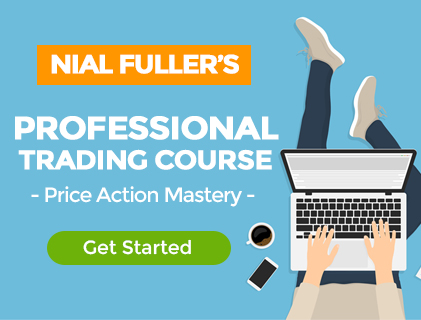Part 2 – How to Become a Pro FX Trader: Testing Your Trading Skills
Testing Your Skill in the Market
 Last week, in Part 1 of this mini-series we discussed how to build the foundation of your Forex trading career. If you missed Part 1 click here.
Last week, in Part 1 of this mini-series we discussed how to build the foundation of your Forex trading career. If you missed Part 1 click here.
Here’s a quick review of what we covered last week:
Step 1) Be honest with yourself about Forex trading
Step 2) Learn the basics of Forex trading
Step 3) Learn to trade Forex with an effective trading strategy
In today’s lesson we are going to continue where we left off last week by moving on to developing a Forex trading plan, trading journal, and demo trading. Like it or not, these seemingly “boring” aspects of Forex trading are essential to achieving success as a trader. If you ignore these critical pieces of the “pie”, you will quickly join the crowd of failed traders. Creating a trading plan and journal is the basis of becoming a disciplined trader and developing positive trading habits. After you have completed steps 1-3 in Part 1 of this mini-series, as well as steps 4 and 5 in this part, you can demo-trade your new trading strategy and see how it performs in real-time market conditions.
Why this part of the mini-series is CRITICAL to becoming a pro trader
Before we dive into the next 3 steps in this mini-series, I want to take a minute to explain to you guys why the points discussed here today are absolutely critical to becoming a professional Forex trader.
I know what you are thinking right now in the back of your head, “Trading plans and journals and demo trading are boring, and I don’t really need these things”. I know you are thinking that because I thought it before too.
However, I quickly realized that thinking something alone does not make it true. As much as you might think Forex trading plans and journals are boring, and maybe even demo trading, that does not change the fact that they are critical tools to developing yourself into a professional Forex trader. So, SUCK IT UP and do whatever you have to do to make yourself enjoy the process of creating these tools and using them CONSISTENTLY. If you don’t want to follow these next three steps then I suggest you pack your trading bags now and pursue a different career, because you won’t make it without them, here’s why:
Step 4: Create (and use) a Forex trading plan
 In step 3 from last week’s lesson, we left off talking about learning to trade Forex with a high-probability trading strategy like price action. The next step to becoming a professional trader is to turn your trading strategy into a comprehensive yet concise forex trading plan, and actually using that trading plan after creating it.
In step 3 from last week’s lesson, we left off talking about learning to trade Forex with a high-probability trading strategy like price action. The next step to becoming a professional trader is to turn your trading strategy into a comprehensive yet concise forex trading plan, and actually using that trading plan after creating it.
Creating a trading plan around your trading strategy is critical for refining your trading approach and developing an organized and structured trading routine that will guide you when you switch to real money trading as well as help you avoid becoming an emotional trader. Yet, the vast majority of traders never even attempt to create a trading plan, instead, they think they can just “plan” on the go or that they are “so good” at trading that they just don’t need a plan. Well, the vast majority of traders also lose money in the markets…no it’s not a coincidence.
When you actually take the time to boil down your trading strategy to its core components and create an effective trading plan out of it, you gain a deeper understanding of your trading strategy and how to use it. You also create a tangible daily guide for your Forex trading that will work to keep you objective, on-track, and disciplined, THIS is the most important reason for creating a good Forex trading plan.
After first trying to trade without a trading plan like most traders do, I found that I was straying off course a lot and starting to just gamble my money in the markets rather than sticking to my high-probability forex price action trading edge. I soon realized that it’s one thing to understand your trading strategy in your mind, but it’s another thing all together to actually execute it with discipline and consistency in real-time market conditions.
HERE is where a Forex trading plan comes in. It is a written (or typed) outline of your overall trading approach, and you have it by your side whenever you are trading. Your trading plan helps you stay true to your trading strategy and to the principals that you decided were best to trade with when you created your trading plan and when you were thus totally objective and unemotional. So, a Forex trading plan gives you a predefined guide to make your decisions off of while analyzing the markets, this allows you to make logical and objective trading decisions rather than the emotional knee-jerk trading decisions that so many traders end up trading off of. If you don’t know how to make a Forex trading plan you should read this article: how to make a Forex trading plan.
Oh, and don’t make the common mistake that many traders make of spending the time to create a trading plan and then never using it. If you don’t actually use your trading plan it’s not going to help you (surprise surprise!). Also, you may need to tweak your trading plan as you progress as a trader; nothing wrong with this, as long as you are working on your trading plan while you are not in the market and thus totally objective, you are on the right path.
Step 5: Create (and use) a Forex trading journal
 After you’ve created a successful Forex trading plan, it’s time to create a Forex trading journal so that you can track your progress as a trader.
After you’ve created a successful Forex trading plan, it’s time to create a Forex trading journal so that you can track your progress as a trader.
Your trading journal can be thought of as the “engine” that keeps your trading moving in a disciplined and organized manner. Here are the main reasons to create and use a Forex trading journal if you want to become a pro Forex trader:
• Trading journals keep you disciplined – Whilst creating a trading plan will help you become a disciplined trader, it can be another thing all together to remain a disciplined trader. Becoming a disciplined trader means nothing if it all goes out the window after you hit a few losing trades and start trading emotionally as a result. A trading journal provides you with a tangible tool that helps you stay accountable, in essence, you become accountable to your trading journal. At least that’s how you need to think about it. Your trading journal will be a direct and in-your-face reflection of your ability as a trader. If your trading skill is not quite where it should be, you will see this reflected in your trading journal, if your mindset is not quite where it should be, you’ll see this reflected in your trading journal as well.
You are creating an on-going journal of your ability or lack thereof to trade the markets successfully. The longer you maintain your journal and trade your trading plan in a disciplined and consistent manner, the more discipline and consistency you will see in your trading results. Over time, you will begin to think of your trading journal as a testament to your ability to trade, and you will be PROUD of it, as you should be. This will work to reinforce your desire to maintain positive trading habits and to not stray off course into emotional-gambler trading land.
• You need a track record – You need a track record if you want anyone to take you seriously as a professionally trader. If you are trading Forex with a small account and hoping to find an investor to fund you, you absolutely have to have a consistently documented track record that shows 6 months or more of successful trading, in most legitimate cases that is. Furthermore, even if you aren’t looking for funding, your track record should be viewed as an integral part of your overall trading strategy that you passionately love to maintain, if you think of it like this I promise your trading will improve.
• Trading journals develop winning trading habits – As I mentioned previously, a trading journal will work to develop and reinforce positive trading habits. The process and routine of keeping a running journal of all your trades will work to make trading seem like more of a business. Since you need to learn that Forex trading is a business anyways, this is a good way to do that. You will work to reinforce the benefits of discipline and patience when you keep a trading journal. Once you see your discipline and patience paying off over a period of time, you will gain a deeper understanding of why they are important and this will work to make you ENJOY being a patient and disciplined trader, rather than wanting to “run and gun” like so many other traders do.
Step 6: Demo trade first
 After you’ve completed steps 1-5 of this series, it’s time to try out your trading strategy, trading plan, and trading journal in real-time market conditions. The process of demo trading is a good testing-ground for traders, and it’s essential for working out the kinks in your trading plan and really forging it into something you can be confident about when you move on to real-money trading.
After you’ve completed steps 1-5 of this series, it’s time to try out your trading strategy, trading plan, and trading journal in real-time market conditions. The process of demo trading is a good testing-ground for traders, and it’s essential for working out the kinks in your trading plan and really forging it into something you can be confident about when you move on to real-money trading.
Now, let me first say that there are some obvious psychological differences between demo trading and live trading, but that doesn’t make the process of demo trading insignificant. Demo trading is an important step for any trader to take after they master their trading strategy and develop it into a solid trading plan. It can also be a tool to use to rehabilitate yourself if you’ve been on a big emotional losing streak in the markets. So, if you find yourself “out of control” in the markets, stop real-money trading and go back to demo until you have successfully regrouped and gained your discipline back.
After you have traded your demo account with consistent success for a period of 3 to 6 months, you can then try your hand at real-money trading. However, don’t take demo trading lightly; you really need to see profitable trading results that were born out of consistently following your trading plan and updating your journal for 3 months or longer before trading live.
In Part 3 of this mini-series (click here to view), we are going to discuss the transition from demo trading to real-money trading, trading psychology, and managing your risk in the market. Stay tuned for that because the topics discussed next week are what really separate the amateur Forex traders from the professionals. If you want to learn more about my price action trading strategies and the topics discussed in today’s lesson, check out my Forex price action trading course and members’ community.






Very informatively! Thanks
Thanks, great stuff
Hi Nial …. this awesome stuff. I have fallen behind due to other issues but I am going through all of this now non-stop! Thanks again!
Hi Nial,
Hope you are well. Thank you for another superb and fantastic lesson.
Thank you for all your help
Thanks and Regards
Gurpal
I am a Nigerian and currently living in Nigeria, am really interested in your Forex trading course. how can i pay and for your course?
Kay, Contact me via contact us section for more information.
Nial,
Once again an easy read making perfect sense… I myself am
only on a demo account and really need to focus and create an edge and trading plan..
Thanks
Thanks good stuff.
Nial, I love you. Your analysis are very insightful. I strongly believe that this site should be recommended to anyone that wants to go into forex. Forex has really been frustrating /confusing to me, Demo trading equally becoming boring, but with the discovery of this site, i can actually say that i am gradually getting to really understand and enjoy forex.
Thanks Nial….Can’t hardly wait for ur next article
I like Your conseils Nial. I’going de better on better in my trading . Thanks Nial
very very exllent for all new as well professionals.
Thanks Nial, great advice.
Thank you Nial. This is very useful when trading starts.
Great article Nial, I am looking forward to part 3. Thanks!
Great article Nial!
very sound advice laid out in laymens terms and not a
rigmorole of gibberish.
Hello Nial
Thank you again, especially about the journal.
Galen
I LOVE THIS TIPS,,,,NIAL,,KEEP IT UP
thanks
Great article, I keep screenshots of all my trades and have seen where I have gone wrong through the screen shots after taking bad trades and reviewing, otherwise you would never learn. I can also see more clearly the reasons for the winning trades – when my strategy works. I believe this is key as well to learning how to trade, take your time with it and keep reviewing your trades and in the end something will click – it doesn’t matter how long that takes as we all learn at different rates. My first year was a disaster, i didn’t know what I was doing, but then I went to demo trading and I also agree with Niall on that too that demo trading until you see consistency will save you a small fortune. Thanks for the article Niall.
I use it. Everything what is written in this article is true. This is the mandatory article for ewery forex traders. Read it and use it.
Great stuff Nial, will be looking forward to part 3
Thanks
thousand thanks for your great job.im looking foward to see ur next article….
Nial,
I hear you a lot about a trading plan and how essential it is but I (like a lot of other newbies) have no idea what one looks like.
I understand it may well be different for every trader but considering “how important” a trading plan is, would you kindly share a “sample” Trading Plan that we can model ours after (at least in the members area)?
Thanks
Thanks Nial.
It a great truth.
I have followed and give you peace in mind…
Cheers
Thanks for the information. It gives me confidence just to know that you are there for us with these great course notes. Your notes and information are worth a million dollars alone.
Regards as always
Peter
Dear ,my Prof’, you have continually given us the great lecture again.
Great thanks a million times.
very good
I have done what Nial has said in this article and what he says is true – I nearly have a years results – showing a double digit percentage return – and I am really proud of my trade journal . I see it like a trading CV or resume- can I encourage all those reading this who do not have a trade journal that you almost certainly MUST use one in order to progress as a trader. Nial is a great coach and he has helped me lay the foundations for a successful forex business through articles such as this one…..If you listen and implement his advice you may be able to do the same too….
Hi Nial
Great article this week as always.
Essentially it seems to me about turning dreams into reality:
Think log and hard about what it is you want to do
Plan how you are going to do it
Execute the plan in real time to see whether it delivers desired result
If not, return to the plan to find out where the plan could be enhanced (with the benefit of hindsight).
Execute the enhanced plan in real time to see whether it better delivers
(next week)
Execute the plan in real time with real money
Review performance to see how closely it aligns to the ‘demo’ results
continue to iterate the above until actual performance consistently aligns with desired (planned)
Seems so easy, but it certainly isn’t
Have a great Easter break, best
Paul
Excellent serie, thanks a lot.
It takes time to understand how important those steps are. Maybe you have to try the hard way first to be able to understand them? Atleast for me, but I’m the kind of person who tries first and then reads the manual :-)
Anyway, thanks again.
Tomson
Another great write up Nial. It hurts to hear the truth but it always helps.
Thanks